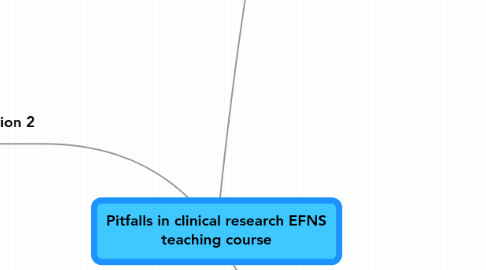
1. RCT presentation 1
1.1. Validity
1.1.1. external effects
1.1.2. Components observed effect
1.1.3. Learning from single observations or on basis of experience
1.1.4. regressionto the mean
1.1.5. Treatment effect
1.2. Miscellaneous
1.2.1. Phases of clinical trials
1.2.1.1. picture
1.2.2. Subgroup analysis
1.2.2.1. picture
1.2.2.2. be careful
1.2.2.2.1. usually too little patients to do subgroups
1.2.3. Factorial design
1.2.3.1. picture
1.2.3.2. reference
1.2.3.2.1. dennis black
1.2.4. Cross over designs
1.2.4.1. picture
1.2.4.1.1. picture
1.2.5. Stopping rules
1.2.5.1. picture
1.2.6. Primary outcome measures
1.2.6.1. picture
1.2.7. Secondary outcome measures
1.2.7.1. picture
1.2.8. Clinical trial
1.2.8.1. paradigm for etiologic research
1.2.8.1.1. you need
1.3. Study size
1.3.1. picture
1.4. Aim of intervention
1.4.1. Explanatory study
1.4.2. Pragmatic study
1.4.3. example
1.4.3.1. picture
1.5. Selection
1.5.1. Comparability of natural history
1.5.1.1. NHi = NHr
1.6. Comparability of extraneous effects (EFi = EFr)
1.6.1. placebo or fake treatment iin the reference group
1.6.2. picture
1.7. "Intention to treat" analysis
1.7.1. picture
1.8. Comparability of information
1.8.1. IBi = IBr
1.8.2. Doctors
1.8.3. Patients
1.8.4. picture
1.8.4.1. picture
1.8.5. Randomisation is not always needed
1.8.5.1. very soft
1.8.5.2. very hard outcomes
1.8.5.3. everything in middle YES
1.9. Basic data analysis
1.9.1. picture - data analysis 1
1.9.2. picture - data analysis 2
1.9.3. picture - data analysis 3
1.10. CONSORT 2010 checklist of information to include when reporting a randomised trial
1.10.1. important to look at
1.10.2. example ICSS trial
1.10.2.1. International Carotid Stent Trial
1.10.2.2. Elegibility
1.10.2.3. interventions
1.10.2.4. randomisation
1.10.2.5. outcome measures
1.10.2.5.1. picture
1.10.2.5.2. Outcome assessment blinded
1.10.2.6. Sample Size
1.10.2.6.1. picture
1.10.2.7. New node
1.11. Validity and generalisability
1.11.1. picture
2. presentation 2
2.1. picture
2.2. Cohort study
2.2.1. Example
2.2.1.1. Basal artery thrombosis
2.2.1.2. picture
2.2.1.3. aim
2.2.1.3.1. BASICS study
2.2.1.4. Determinants
2.2.1.5. primary outcome
2.2.1.5.1. picture
2.2.1.6. Baseline variables
2.2.1.6.1. picture
2.2.1.6.2. results picture
2.2.1.7. Risk rations
2.2.1.8. Reflections
2.2.1.8.1. picture 1
2.2.1.8.2. picture 2
2.3. Case control study
2.3.1. Example
2.3.1.1. picture
2.3.1.2. Lay out data case-control study
2.3.1.2.1. picture
2.3.1.3. Advantages case-control study
2.3.1.3.1. picture
2.3.1.4. Design options in case-control studies
2.3.1.4.1. picture
2.3.1.4.2. picture
2.3.1.5. Selection of controls
2.3.1.5.1. picture
2.3.1.5.2. picture
2.3.1.6. RATIO study - 1
2.3.1.7. Ratio study - 2
2.3.1.7.1. no pic
2.3.1.8. Biases
2.3.1.8.1. picture
2.3.1.8.2. solutions
2.3.1.9. Data RATIO study - 3
2.3.1.9.1. picture
2.3.1.10. Data RATIO - 4
2.3.1.10.1. picture
3. Presentation 3
3.1. Common errors in research
3.2. prognosis
3.2.1. pitfalls in studies of prognosis
3.2.1.1. selection by indication
3.2.1.2. inappropriate measures
3.2.1.3. known risk factors shall always be included in equations
3.2.1.4. Chance findings always happen
3.3. statistics
3.3.1. interval scale vs ordinal scale
3.3.2. Is your data normal divided?
3.3.2.1. check the shape of your data
3.4. diagnosis
3.4.1. Take a structure approach to diagnosis
3.4.1.1. don't rely on chance
3.4.1.2. Tests have false positive / negative results
3.4.1.2.1. eg chance to have MS
3.4.1.2.2. eg chance to have white spots on brain in MRI
3.4.1.2.3. picture study
3.4.1.3. Sensitivity / specificity
3.4.1.3.1. A single measure of test properties
3.4.1.3.2. can be combined with a priori odds
